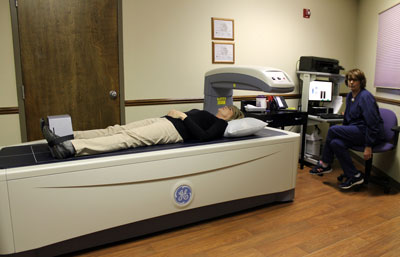New Bone Densitometer at Brookings Health System Helps Detect Osteoporosis
- December 14, 2015

Brookings Health System recently acquired a new bone densitometer to aid physicians in osteoporosis diagnosis.
Osteoporosis gradually thins and weakens bones, often resulting in crippling and painful fractures. A bone densitometer measures bone mineral density using small amounts of x-ray called “dual-energy x-ray absorptiometry”, or DXA, to help gauge a patient’s risk for osteoporotic fractures.
“We’ve updated our technology to better serve local patients and assist in early detection and treatment of osteoporosis,” said Imaging Director Tim Watson. “Our new bone densitometer offers higher precision scans with better image detail compared to our previous device. It also uses lower amounts of x-ray dose and patient test times are quicker.”
The bone densitometer measures a patient’s spine and hip, where most osteoporotic fractures occur. The test compares a patient’s bone quality to that of a young adult at peak bone strength. It also compares the results to people of the patient’s same age. Physicians can follow a patient’s bone density over time and use the tests to determine the effects of osteoporosis treatment.
Osteoporosis affects 44 million Americans and results in 1 million hip, spine and wrist fractures annually. While women over age 50 are at the greatest risk for developing the disease, a low calcium diet, lack of exercise and a small, thin frame are also risk factors. Osteoporosis signs rarely show until a patient experiences significant bone loss. Visible symptoms include height loss and curvature along the upper back.
Patients concerned about osteoporosis should discuss the condition and their risk factors with their doctor. If appropriate, their doctor can refer them for a bone densitometer test at Brookings Health System.
Osteoporosis screening is just one of the medical imaging services offered at Brookings Health System. Local patients can also receive MRI, CT, ultrasound, x-ray and nuclear medicine procedures close to home, saving them time and travel expenses. For more information, please visit www.brookingshealth.org/Imaging.
About Brookings Health System
Brookings Health System, located in Brookings, South Dakota, includes a 49-bed hospital, the 79-bed The Neighborhoods at Brookview nursing home, Brookhaven Estates senior living apartments, Yorkshire Eye Clinic, and medical clinics in Arlington, White and Volga, South Dakota. It is a non-profit, city-owned facility that offers the community a full range of inpatient, outpatient, surgical and extended care services. The emergency room is staffed 24 hours a day and provides around the clock patient needs ranging from minor injuries to life threatening crises. For more information about the services offered at Brookings Health System, please call (605) 696-9000 or visit us on the Web at brookingshealth.org.

